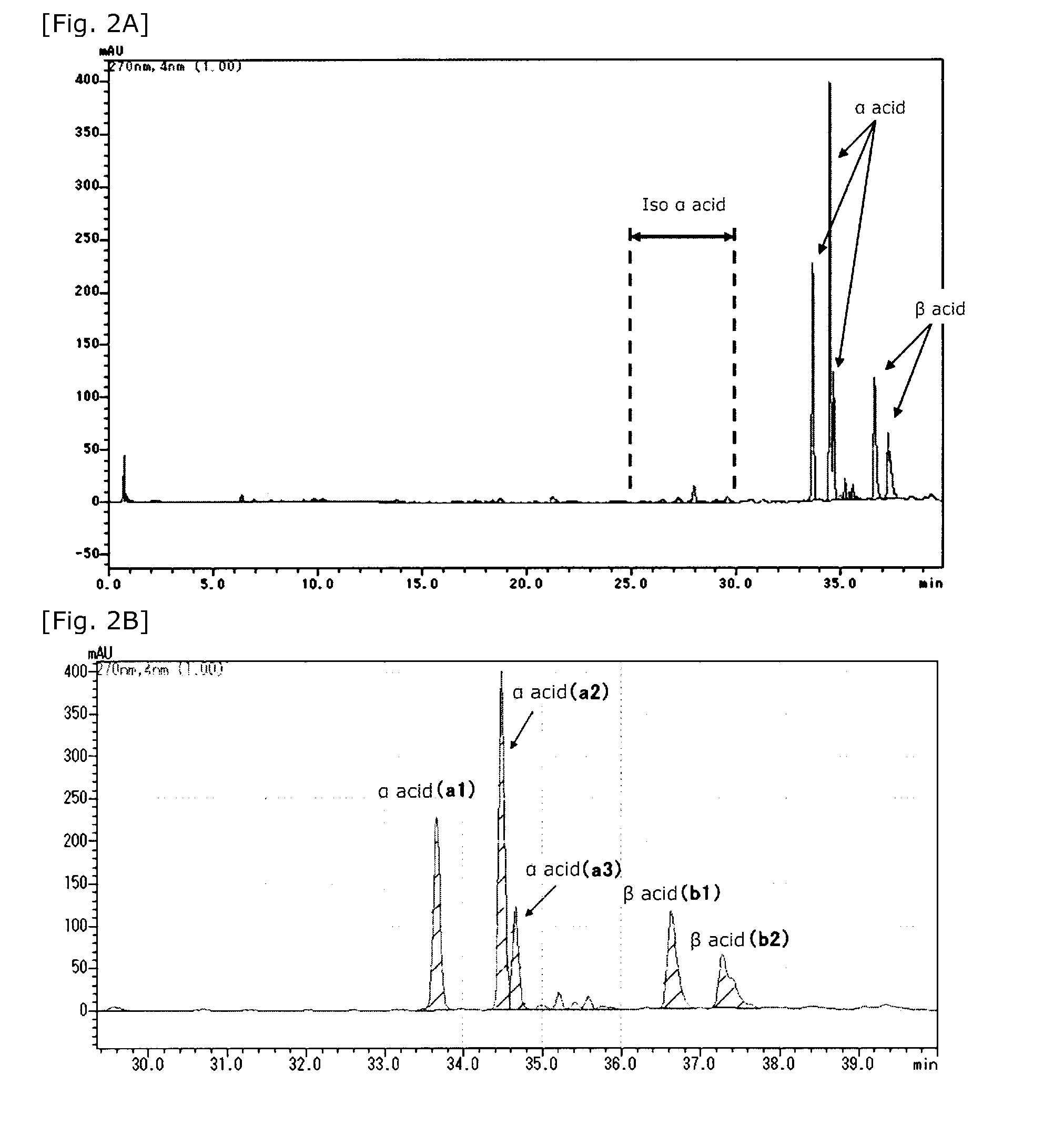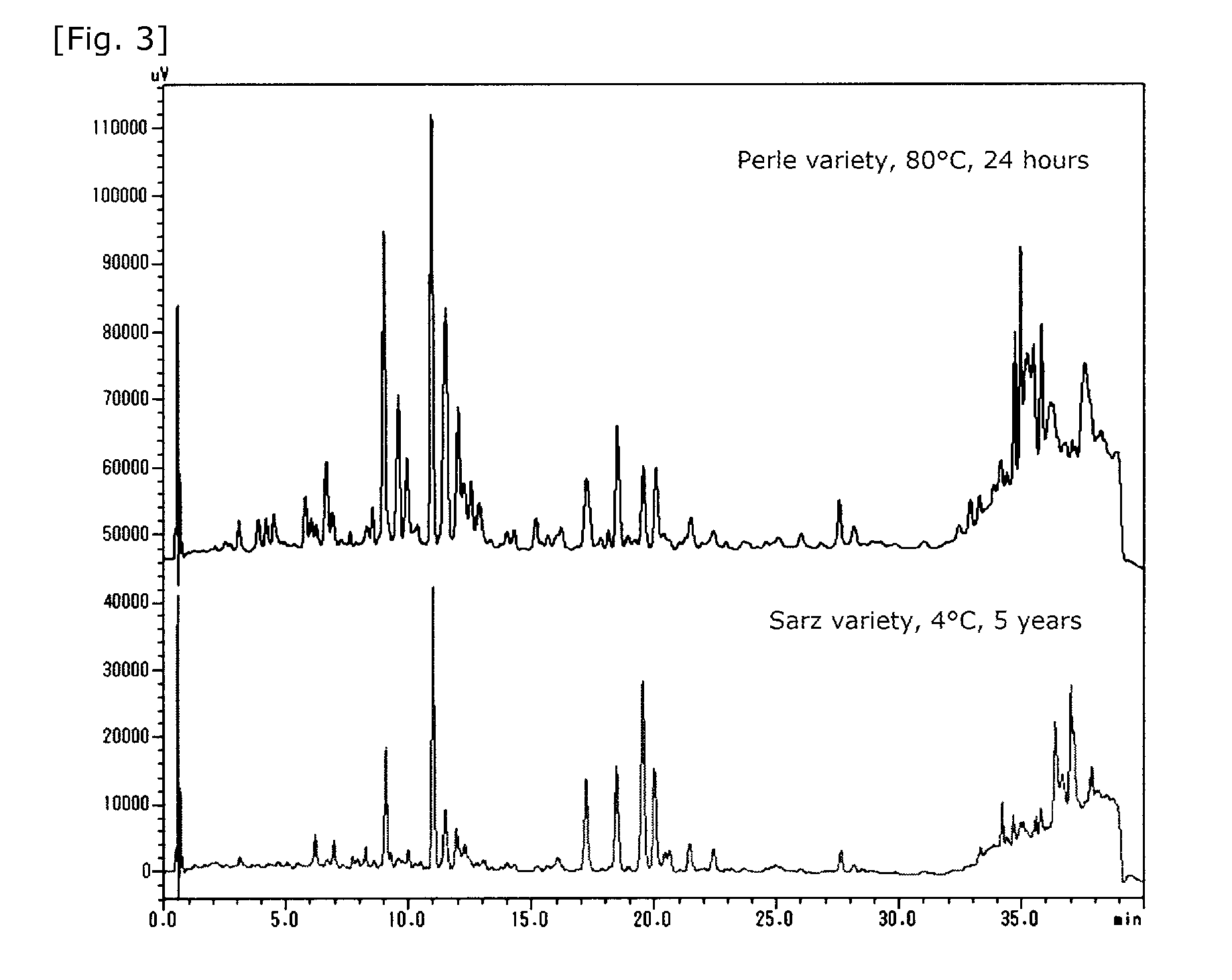Hop oxidation-reaction product, preparing method thereof and use thereof
- Summary
- Abstract
- Description
- Claims
- Application Information
AI Technical Summary
Benefits of technology
Problems solved by technology
Method used
Image
Examples
example 1
Preparation of the Product of Hop Pellet Oxidation-Reaction
[0070]For a hop, the pelleted Hallertauer Perle variety (HPE variety) was used. The hop was ground with a mill, and the heating reaction time was kept up to 24 hours at 80° C. The resulting product was pre-treated as described below and then subjected to HPLC analysis.
[0071]Pre-Treatment for Product Analysis
[0072]A sample of the product was added to ethanol to give 10% w / v, and extracted at 50° C. for 1 hour. The resulting extract was diluted 10 times with ethanol.
[0073]HPLC System Configuration
[0074]Pump: LC-10Advp×3 (SHIMADZU CORPORATION)
[0075]Degasser: DGU-20A5 (SHIMADZU CORPORATION)
[0076]System controller: CBM-20A (SHIMADZU CORPORATION)
[0077]Autosampler: SIL-20ACHT (SHIMADZU CORPORATION)
[0078]Column oven: CTO-20AC (SHIMADZU CORPORATION)
[0079]Photodiode array detector: SPD-M 20A (SHIMADZU CORPORATION)
[0080]Waveform analysis software: LCSolution (SHIMADZU CORPORATION)
[0081]HPLC Conditions
[0082]Column: Alltima C18 2.1 mm I....
example 2
Extraction of the Oxidation-Reaction Product of a Hop (Removal of an Unpleasant Odor)
[0099]The product in Example 1 contains fatty acids and the like resulted from the oxidation-reaction, and pleasant ingestion was thought to be difficult because of the unpleasant odor depending on a mode of ingestion. Accordingly, the unpleasant odor was tried to be removed.
[0100]Ethanol was added to 100 g of the product of Example 1 to give a volume of 1 L, and stirred at 55° C. for 1 hour to obtain an ethanol extract.
[0101]Subsequently, extraction residues were removed by filtration, and 22 g of a dark green solid was obtained by performing concentration.
[0102]Sensory evaluation was performed by a panel of six in-house staffs according to the following method for the unpleasant odor of the extract (a dark green solid) from Example 2 prepared by the extraction as described above and the product (a control) from Example 1. The extract of Example 2 or the control was added to a 10 mM citrate buffer ...
example 3
Sensory Evaluation for a Bitter Taste
[0107]A bitter taste was compared for the extract of Example 2 by sensory evaluation.
[0108]Evaluation Method in the Sensory Evaluation for a Bitter Taste
[0109]For a bitter taste of the extract of Example 2 and the product (the control) obtained by extracting an unoxidized hop pellet according to a similar method as Example 2, sensory evaluation was performed by a panel of six in-house staffs according to the following methods. The extract was boiled and dissolved in 10 mM citrate buffer (pH 5.5), and the extract of Example 2 or the control was diluted to give 50 ppm in terms of isohumulone equivalence, and used for the sensory evaluation.
[0110]Sensory evaluation was performed in which several mL of a sample was put into the mouth, and evaluated in accordance with the evaluation criteria. The result was calculated as the mean of scores from the six staffs.
Evaluation Criteria
[0111]
TABLE 6Evaluation itemsEvaluation criteriaScoreBitter tasteBitter ta...
PUM
 Login to View More
Login to View More Abstract
Description
Claims
Application Information
 Login to View More
Login to View More - R&D
- Intellectual Property
- Life Sciences
- Materials
- Tech Scout
- Unparalleled Data Quality
- Higher Quality Content
- 60% Fewer Hallucinations
Browse by: Latest US Patents, China's latest patents, Technical Efficacy Thesaurus, Application Domain, Technology Topic, Popular Technical Reports.
© 2025 PatSnap. All rights reserved.Legal|Privacy policy|Modern Slavery Act Transparency Statement|Sitemap|About US| Contact US: help@patsnap.com



